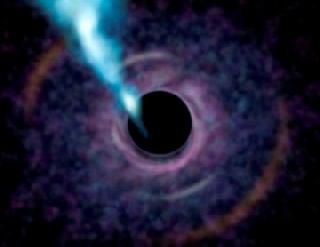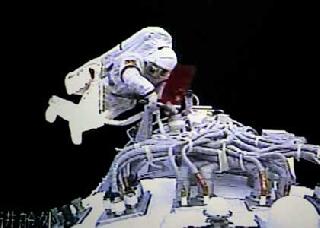
Artist's concept of what a future telescope might see in looking at the black hole at the heart of the galaxy M87. A Texas University photo
LONDON (PTI): Astronomers have discovered what they say is the biggest ever black hole that weighs the same as 6.6 billion Suns and could swallow our entire solar system.
According to the scientists, the black hole, spotted in the giant elliptical galaxy M87, is as large as the orbit of Neptune.
As a point of comparison, the black hole at the centre of the Milky Way is 1,000 times smaller than this one which has been observed some 50 million light years away.
A black hole is a region of space from which nothing, not even light, can escape. It is the result of the deformation of space-time caused by a very compact mass.
Scientists, who used a specially adapted telescope in Hawaii to observe M87, believe that the massive black hole found there is more than twice as heavy as had been previously thought, catapulting it into the record books, the Daily Mail reported.
The researchers said that it may have formed as a result of hundreds of smaller black holes merging into one at some point in the past.
Speaking about the discovery, astronomer Karl Gebhardt of the University of Texas in Austin said: "It could swallow our solar system whole."
Astronomer George Djorgovski, of the California Institute of Technology in Pasadena, who was also involved in the research, added that the chance to study such huge black holes is not just a curio for the record books.
He said: "In fact, future observations of this object might finally help us prove that what we call black holes are really black holes.
"Until now, there has been no direct observational evidence at all for the existence of event horizons, which are the true signatures of black holes."
According to Prof Gebhardt, the discovery was made using the adaptive optics capability of the 8.1-metre Frederick C Gillett Gemini Telescope on Mauna Kea, Hawaii.
He and his team were able to track stars orbiting the black hole at up to 500 km per second, which allowed them to work out its mass.
"It's the most accurate mass estimate ever obtained for a supermassive black hole," he said.
Despite the discovery, the record looks unlikely to stand for long as over the coming decade astronomers plan to link up telescopes all over the world to create a giant array that will significantly increase their ability to find and observe black holes.
 Previous Article
Previous Article Next Article
Next Article











The Indian Air Force, in its flight trials evaluation report submitted before the Defence Ministry l..
view articleAn insight into the Medium Multi-Role Combat Aircraft competition...
view articleSky enthusiasts can now spot the International Space Station (ISS) commanded by Indian-American astr..
view article